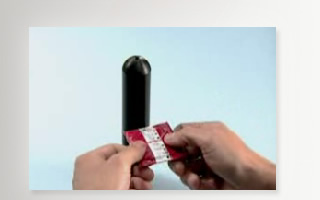PRONTO CONDOMS with applicator (youtube video!)
http://en.wikipedia.org/wiki/Pronto_condoms

Pronto condoms are a brand of sheath being released in South Africa, designed by Willem van Rensburg. The outside protective packaging acts as the condom applicator as well, which reduces the time needed to utilize the condom. The designer was inspired to create a new style of condom because, according to him, people find the slow process of applying a condom is "a passion-killer and they're willing to take their chances."
Approach your throbbing manhood with caution
http://www.youtube.com/watch?feature=player_embedded&v=kMriPq9k278

The Comstock Act, 17 Stat. 598, enacted March 3, 1873, was a United States federal law which amended the Post Office Act[1] and made it illegal to send any "obscene, lewd, and/or lascivious" materials through the mail, including contraceptive devices and information. In addition to banning contraceptives, this act also banned the distribution of information on abortion for educational purposes. Twenty-four states passed similar prohibitions on materials distributed within the states. These state and federal restrictions are collectively known as the Comstock laws.

The German military was the first to promote condom use among its soldiers, beginning in the later 19th century.
During World War I, the United States and (at the beginning of the war only) Britain were the only countries with soldiers in Europe who did not provide condoms and promote their use.
The phenomenon of decreasing use of condoms as disease preventatives has been called prevention fatigue or condom fatigue. Observers have cited condom fatigue in both Europe and North America
As one response, manufacturers have changed the tone of their advertisements from scary to humorous
New developments continue to occur in the condom market, with the first polyurethane condom—branded Avanti and produced by the manufacturer of Durex—introduced in the 1990s
and the first custom sized-to-fit condom, called TheyFit, introduced in 2003.

Polyurethane condoms have gained FDA approval for sale in the United States as an effective method of contraception and HIV prevention, and under laboratory conditions have been shown to be just as effective as latex for these purposes
June 2011: An erection-enhancing condom recommended for European approval and will take around one month to receive CE mark certification after recommendation. In a double blind test the boosting condom gave a significant proportion that it was better than a standard condom which increased the penis size and longer lasting sexual experience for women. The boosting condom used gel in its tips that dilates the arteries and increased blood flow to penis make a firmer and bigger erection.
In March 2010, the Swiss Government announced that it was planning to promote smaller condoms intended for boys of 12–14 years old. The Government was concerned about the pregnancy rate among adolescent girls, and also about the potential spread of AIDS among this age group. This was due to the fact that standard condoms were too wide and consequently failed to afford protection to adolescent boys during vaginal and anal intercourse. Family planning groups and the Swiss Aids Federation campaigned to have a narrower condom produced for adolescent use after a number of studies, including a government study researched at the Centre for Development and Personality Psychology at Basel University, found that standard condoms were unsuitable for boys in this age range, and that the condoms either failed during use or that the boys rejected them altogether because they were too wide, and consequently they used no protection at all
As a result of these studies, a condom aimed at 12 to 14 year old boys is now produced and is available in Switzerland and in certain other countries. Manufactured by Ceylor, the 'Hotshot' is a narrower condom with a tight band at the opening to ensure that it remains on the boy's penis during intercourse. A standard condom has a diameter of 2 inches (5.2 cm) whereas the Hotshot has a diameter of 1.7 inches (4.5 cm). Both are the same length – 7.4 inches (19 cm).
In a German study of 12,970 13 to 19-year-olds,a quarter of the boys surveyed also said a standard condom was too large. Other manufacturers, such as Durex, also produce smaller than average condoms such as Durex Love which is aimed at this end of the teenage market.
Male condoms are usually packaged inside a foil wrapper, in a rolled-up form, and are designed to be applied to the tip of the penis and then unrolled over the erect penis. It is important that some space be left in the tip of the condom so that semen has a place to collect; otherwise it may be forced out of the base of the device. After use, it is recommended the condom be wrapped in tissue or tied in a knot, then disposed of in a trash receptacle.
Some couples find that putting on a condom interrupts sex, although others incorporate condom application as part of their foreplay. Some men and women find the physical barrier of a condom dulls sensation. Advantages of dulled sensation can include prolonged erection and delayed ejaculation; disadvantages might include a loss of some sexual excitement.

Pronto condoms are a brand of sheath being released in South Africa, designed by Willem van Rensburg. The outside protective packaging acts as the condom applicator as well, which reduces the time needed to utilize the condom. The designer was inspired to create a new style of condom because, according to him, people find the slow process of applying a condom is "a passion-killer and they're willing to take their chances."
Approach your throbbing manhood with caution
http://www.youtube.com/watch?feature=player_embedded&v=kMriPq9k278

The Comstock Act, 17 Stat. 598, enacted March 3, 1873, was a United States federal law which amended the Post Office Act[1] and made it illegal to send any "obscene, lewd, and/or lascivious" materials through the mail, including contraceptive devices and information. In addition to banning contraceptives, this act also banned the distribution of information on abortion for educational purposes. Twenty-four states passed similar prohibitions on materials distributed within the states. These state and federal restrictions are collectively known as the Comstock laws.

The German military was the first to promote condom use among its soldiers, beginning in the later 19th century.
During World War I, the United States and (at the beginning of the war only) Britain were the only countries with soldiers in Europe who did not provide condoms and promote their use.
The phenomenon of decreasing use of condoms as disease preventatives has been called prevention fatigue or condom fatigue. Observers have cited condom fatigue in both Europe and North America
As one response, manufacturers have changed the tone of their advertisements from scary to humorous
New developments continue to occur in the condom market, with the first polyurethane condom—branded Avanti and produced by the manufacturer of Durex—introduced in the 1990s
and the first custom sized-to-fit condom, called TheyFit, introduced in 2003.

Polyurethane condoms have gained FDA approval for sale in the United States as an effective method of contraception and HIV prevention, and under laboratory conditions have been shown to be just as effective as latex for these purposes
June 2011: An erection-enhancing condom recommended for European approval and will take around one month to receive CE mark certification after recommendation. In a double blind test the boosting condom gave a significant proportion that it was better than a standard condom which increased the penis size and longer lasting sexual experience for women. The boosting condom used gel in its tips that dilates the arteries and increased blood flow to penis make a firmer and bigger erection.
In March 2010, the Swiss Government announced that it was planning to promote smaller condoms intended for boys of 12–14 years old. The Government was concerned about the pregnancy rate among adolescent girls, and also about the potential spread of AIDS among this age group. This was due to the fact that standard condoms were too wide and consequently failed to afford protection to adolescent boys during vaginal and anal intercourse. Family planning groups and the Swiss Aids Federation campaigned to have a narrower condom produced for adolescent use after a number of studies, including a government study researched at the Centre for Development and Personality Psychology at Basel University, found that standard condoms were unsuitable for boys in this age range, and that the condoms either failed during use or that the boys rejected them altogether because they were too wide, and consequently they used no protection at all
As a result of these studies, a condom aimed at 12 to 14 year old boys is now produced and is available in Switzerland and in certain other countries. Manufactured by Ceylor, the 'Hotshot' is a narrower condom with a tight band at the opening to ensure that it remains on the boy's penis during intercourse. A standard condom has a diameter of 2 inches (5.2 cm) whereas the Hotshot has a diameter of 1.7 inches (4.5 cm). Both are the same length – 7.4 inches (19 cm).
In a German study of 12,970 13 to 19-year-olds,a quarter of the boys surveyed also said a standard condom was too large. Other manufacturers, such as Durex, also produce smaller than average condoms such as Durex Love which is aimed at this end of the teenage market.
Male condoms are usually packaged inside a foil wrapper, in a rolled-up form, and are designed to be applied to the tip of the penis and then unrolled over the erect penis. It is important that some space be left in the tip of the condom so that semen has a place to collect; otherwise it may be forced out of the base of the device. After use, it is recommended the condom be wrapped in tissue or tied in a knot, then disposed of in a trash receptacle.
Some couples find that putting on a condom interrupts sex, although others incorporate condom application as part of their foreplay. Some men and women find the physical barrier of a condom dulls sensation. Advantages of dulled sensation can include prolonged erection and delayed ejaculation; disadvantages might include a loss of some sexual excitement.
 Earth's magnetic field:
Earth's magnetic field:

4 Comments:
Really awesome blog. Your blog is really useful for me. Thanks for sharing this informative blog. Keep update your blog.
Durex Condoms Online
mymenhealth
Actilis
Agra 50Mg
Trial Pack
BuyAlpostin Injection
Alsigra 100 Mg
Apcalis oral jelly
Caverta 25mg
caverta 50mg
Cenforce 100mg
Cenforce 120mg
Cenforce 150mg
Cenforce 200mg
Cenforce 25mg
Post a Comment
<< Home